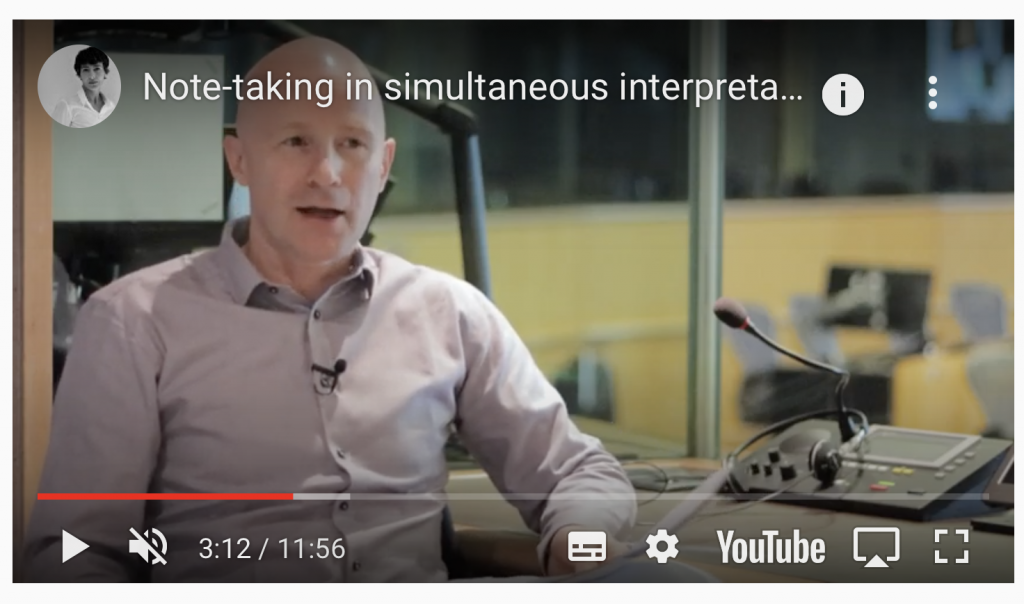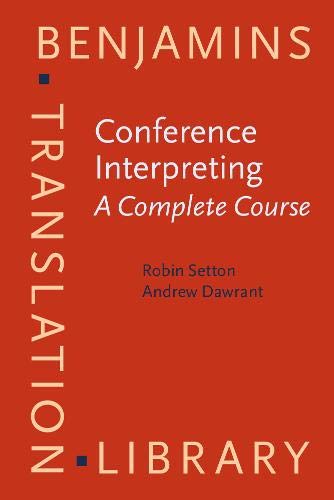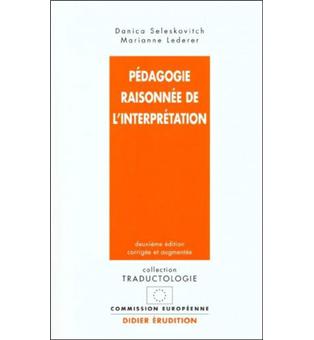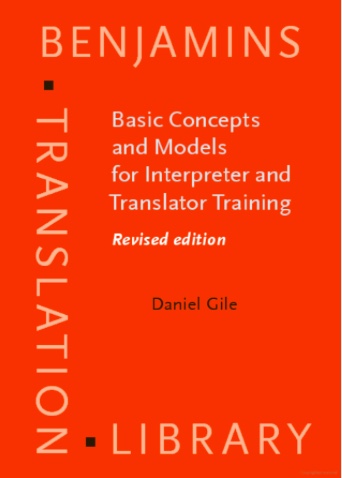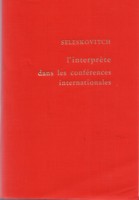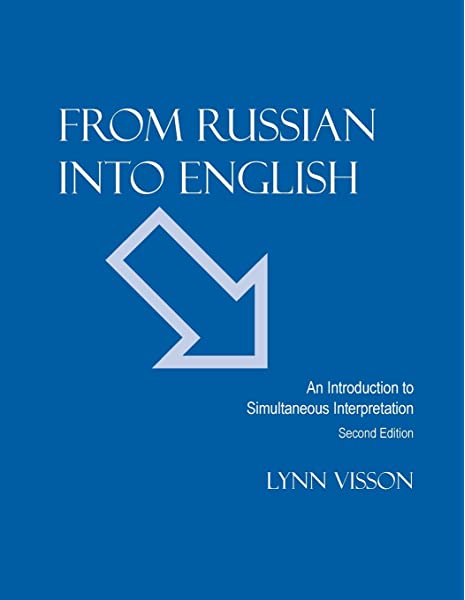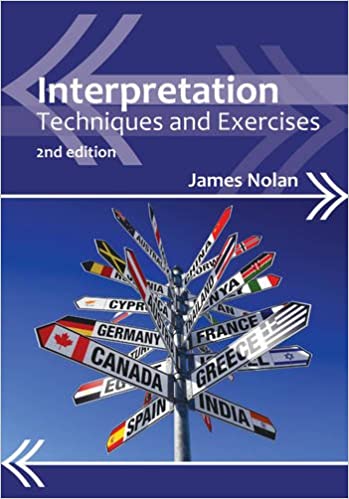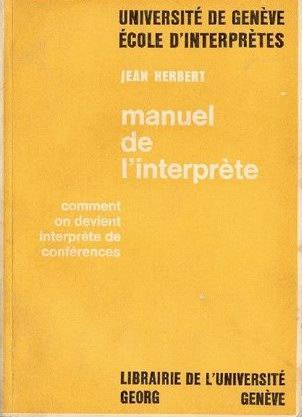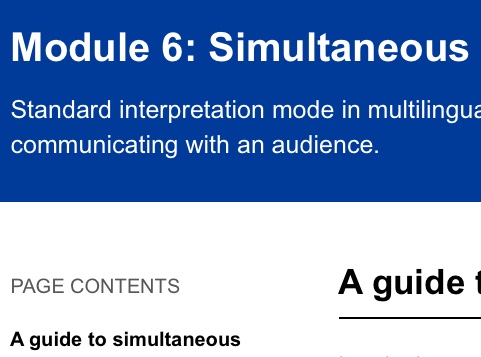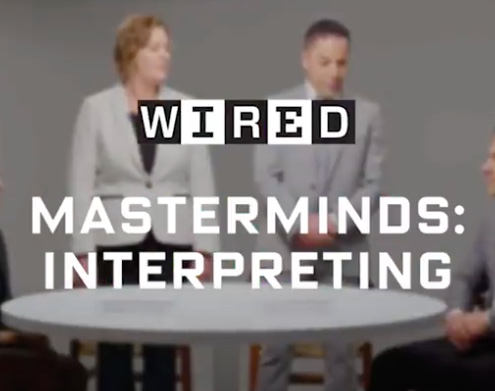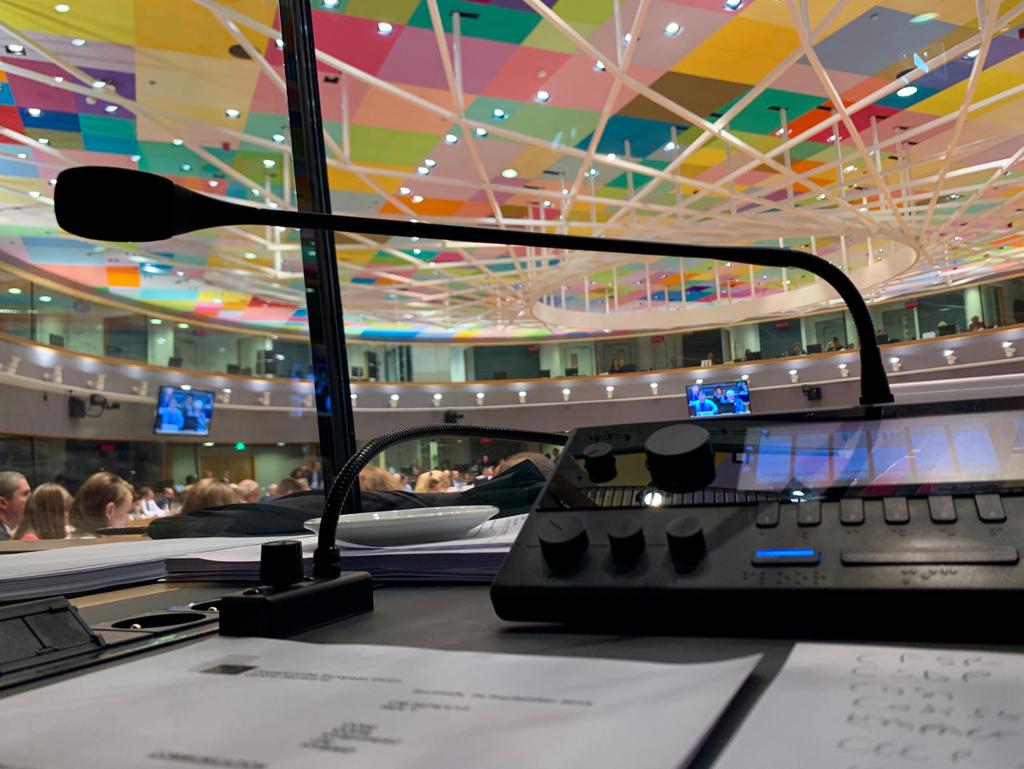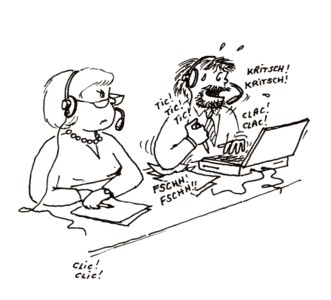This text first appeared in January 2008, FORUM Revue internationale d’interprétation et de traduction / International Journal of Interpretation and Translation 6(2):173-193
Progression in SI training
Introduction
Motivation in SI
Prerequisites in SI
3 stages to SI
Coordination (dual-tasking)
Experimentation (lag/decalage)
Robin Setton
SISU-GIIT (Shanghai); ESIT and ISIT (Paris).
Abstract: Simultaneous interpretation (SI) is required for access to the conference interpretation market, accounting for around 90% of conference interpreters’ work, but its dynamic nature presents a teaching challenge. In leading schools, students are trained for several months in memorising, summarising, paraphrasing, sight translation and consecutive interpreting before being initiated to SI. Many exercises have been proposed, but their empirical evaluation remains difficult. The paper recalls the pre-requisites for initiation to SI (language proficiency, knowledge and analytical ability), and describes some exercises, based on experience in various combinations of European and Asian languages, for SI training in three stages (coordination, experimentation, consolidation). Four exercises in particular – on-line paraphrase, paused SI, ‘taking the plunge’ and ‘tight chunking’ – are recommended for further testing in different phases of SI training. Following the seminal work by Seleskovitch and Lederer (2002), additional focus is placed on language enhancement and techniques for dealing with fast, text-based, institutional discourse (increasingly required, notably in emerging markets) particularly for interpreters working into B. The author welcomes feedback from colleagues who may experiment with any of the recommended exercises.
1. Introduction
SI is widely seen, rightly or wrongly, as the skill which distinguishes conference or ‘high-level’ interpreters from the rest. SI is now well established as the interpretation mode of choice in the world’s high-profile international meetings and as a routine service in multilingual international organisations and many other private or public multilingual gatherings, accounting for 90% of all conference interpreting assignments. This is understandable in view of its obvious attractions as the only form of translation capable of handling multiple languages in real time (not to mention removing interpreters from the meeting room).
The best interpretation requires not just linguistic ability and background knowledge, but also empathy, analysis and an understanding of the context of the communication, and the best interpreters do not all necessarily do high-profile world summits in SI – many provide superb consecutive service behind the scenes to clients ranging from world leaders and financiers to disenfranchised welfare claimants, litigants or refugees. However, in today’s world, with the premium on immediacy and on formal and technical discourse, no interpreter can access the international conference circuit, with its attractive pay, status, variety and opportunities for travel, without offering SI.
In a training programme, therefore, ‘graduation’ to the SI booth is a significant rite of passage from both the trainee’s and the school’s point of view, and most serious programmes insist on ‘mid-point’ exams to ensure that baseline skills and proficiencies have been thoroughly acquired before initiating the trainee into SI. Since SI involves team work, and is also highly exposed, this is the segment of the market that the profession and its schools are most keen to protect by maintaining quality and professionalism. The stringency of the final diploma or certifying exam with SI testifies to their reluctance to admit unqualified candidates to professional practice. But since interpreting is not a legally protected profession, and recruiters are not beholden to schools, candidates who fail this exam may still go out and work, especially if they can offer scarce language combinations. Some may respond better to the real world than to the training environment and soon become acceptable and even excellent interpreters; but an unreliable interpreter – especially if providing relay from a ‘scarce’ but critical language for several other booths – can disable the work of a whole team, cause the failure of an international meeting and seriously damage the image of the profession. It seems that from the trainers’ point of view, the only policy which is at once responsible, realistic and efficient is to be very careful in admitting students to initiation into SI – having the courage to prescribe more preparation, or even advise a change of career plan for those experiencing more fundamental difficulties – and to offer the most intensive, well-thought-out and realistic programme possible to those who are admitted to SI training.
Governments and universities, too, are keen to train students with linguistic gifts to provide language services in the modern and popular form of SI. Politicians, administrators, even academics – and any ‘lay’ observer or user – tend to see interpreting as fast language transfer, and to admire SI as the acme of high-speed linguistic pyrotechnics. In contrast to consecutive, where observers can see some of the ‘workings’ of the task, SI seems rather magical. Rapid reactions and an excellent command of the languages are obviously necessary for SI, but they are supporting rather than core competencies. Inside the black box, and invisible behind the polished performance, there is a hidden ingredient : analysis.
Analysis is a condition sine qua non of SI because in the real world, most speeches will soon defeat even the best and fastest human on-line dictionary. Outsiders inevitably underestimate how fuzzily speakers, however respectable, may express themselves; the differences in the way ideas are expressed in different languages; and more fundamentally, the extent to which context and situation must be understood to make sense of discourse and convey meaning in real communicative situations. Useful set phrases and expressions certainly help, but as secondary tools to complement the basic work of mental analysis. The only thing that all speeches to be interpreted have in common is that the speaker has (or at least is pretending to have) some meaning or message to communicate; little else, in terms of linguistic correctness or coherence, is guaranteed. Only intensive, invisible analysis, drawing on knowledge of the world and the situation, can support the on-line techniques – half-visible and partly-teachable – needed to capture and express meaning from the wide variety of speech-types encountered in real life.
We are happy for our audiences to ignore the inner workings of the black box, but we ourselves need to understand these workings a little for training purposes. The most obvious difference which strikes a beginner moving from consecutive interpreting to SI is the time pressure. (S)he understands the need for analysis from her earlier training, but must now find a way of ‘fitting it in’ alongside listening and speaking. The first thing which seems obvious is that time and effort will need to be saved wherever possible, particularly in understanding the speaker and in searching for the right phrase. It will also help to be able to start, finish, lengthen and shorten sentences as easily as possible, again, to ‘make room’ for understanding and thinking. Clearly, any exercises that hone this kind of linguistic agility will be very helpful : syntactic and pragmatic flexibility are a more permanent and fundamental requirement to SI than the knowledge of words, which can be refreshed and topped-up for each specific event.
SI means making room, or making time, for the priority of each instant, by exploiting knowledge and the flexibilities of language. Knowledge helps to anticipate, and linguistic agility helps us manipulate time by compressing, paraphrasing or elaborating according to need. Without sufficient knowledge and linguistic freedom, there will be little hope of developing the more advanced flexibility needed to handle increasingly fast, difficult and technical speeches. This justifies the definition of baseline general knowledge and linguistic competencies as pre-requisites for beginning SI, along with the ‘analytic reflex’ which should have been acquired through early introductory exercises like same-language paraphrase or ‘retelling’, gisting and summary, followed by three or four months of consecutive interpreting.
2. Motivation for the training strategy
A programme for training simultaneous interpreters can be built on the experiences and intuitions of practising professional trainers, or inferred from a model of the task based on cognitive and linguistic theory, empirical research and the analysis of SI recordings and transcripts. Research and cognitive modelling are instructive, and should be pursued; but when it comes to teaching a task as complex and dynamic a task as simultaneous interpreting, and to groups of uniquely different individuals, the present state of knowledge does not justify replacing a training scheme based on fifty years’ experience with one built on theoretical constructs. This should be clear from a brief examination of the potential contribution of two disciplines, translation studies and psycholinguistics.
A traditional theme in translation studies contrasts form-based (literal) and sense-based (free, ‘de-verbalised’) translation. In observing SI, one thing is immediately clear : both processes must occur and complement each other. On the one hand, we cannot help but experience the sense of speech in a language we understand, forgetting the words used (Sachs 1967); but we also have to find and produce rigid equivalents of technical terms or the names of institutions. An important challenge for SI training in the intermediate stage is to show how to juggle these two processes when argument and terminology come in mixed up together (as they do in live, structured discourse). Can psycholinguistics help? In the literature, complex tasks are often analysed componentially as ‘multitasking’, from which it is often inferred that component sub-tasks for teaching can be mastered separately in targeted exercises, then finally combined into the full task. It is not clear how SI would be analysed into sub-tasks; and no attempt to train interpreters in this way has yet been documented to our knowledge. As for our specific problem, we know of no ‘dual-tasking’ research on how to juggle or combine the two tasks described above – analysis of an unfolding argument and lexical translation.
For the time being, then, we will be guided chiefly by the old pedagogical strategy, well-tried in society and in nature, of nudging the fledgling out of the nest and off the lowest branch of the tree – i.e. initiating her in a simple version of the integral task, in a protected environment (ideal working conditions) which already elicits the same reflexes, excitement, risks and rewards as the full task, but without most of the more notorious difficulties and hazards of real life. These hazards can then be added incrementally: the speeches become gradually more difficult, more formal or structured (or indeed, more problematically incoherent), are delivered faster, and in the later stages, are mixed up with other input like unfamiliar proper names, complex numbers, written text and slides.
Simultaneity is a challenge for the instructor. Theoretical explanations, recommendations and generalisations are hard to apply to classroom practice because of the immediacy, individuality and complexity of SI. Everything is happening at once: the instructor has to listen to two streams of speech and several different students; it is hard to separate problems of language and technique; and each individual student is discovering his or her own limits and abilities, and forming individual habits accordingly, so that suggestions may or may not suit different students. Most instructors rely on their instincts and personal experience, and it is certainly hard to conceive of SI being taught by non-professionals. Much depends on the instructor’s pedagogical gifts, patience and ability to put themselves in the beginner’s place.
3. Prerequisites for SI
The pre-requisites for successful SI training are: trained instructors, preferably[1] themselves practicing professional interpreters; an installation simulating a real conference environment; access to speakers and realistic speech materials; and students who have already reached a baseline in language, knowledge and basic (consecutive) interpreting skills.
2.1. Linguistic comfort and general knowledge
The mid-point exam must obviously filter out students who are too weak in the baseline competencies prerequisite to developing SI technique. These can be stated quite simply:
- Comprehension of most types of speech in their languages must be immediate, and comfortable enough to leave time to spare for analysis, lexical choice where necessary, and for experimenting on-line with techniques like lag control.
- General knowledge and education must be deep and broad enough to ensure they are not constantly unsaddled by alien concepts, names and entities.
- Trainees who must do SI into a B (acquired) language should show enough flexibility and resourcefulness in using that language.
Comprehension and general knowledge should be acquired and strictly verified well before moving to SI, either at admission or during introductory consecutive training. Active SI competence in the B language is achieved by creating and actively exploiting an enabling environment, and by targeted exercises, which are outside the scope of this paper (see e.g. Mackintosh 1989); students’ progress is irregular and hard to predict.
2.2. Linguistic agility and flexibility
With this language-and-knowledge baseline in place, the next level of skill to be developed is linguistic resourcefulness and agility. Linguistic ‘limbering-up’ exercises already introduced include speech-making from sparse notes, but also consecutive interpreting and sight translation, taught as professional skills in their own right. But SI will require additional task-specific, on-line agilities which can be stimulated, for example, by same-language paraphrase, with restructuring (after the usual contextual preparation) of successive chunks of text scrolled down a screen, under (very) gradually increasing time pressure. A variation on this is register-switching, which is particularly challenging in the B language, but should in any case be persevered in, and mastered, in A.
4. SI training in three stages
While we can expect some individual variation in the rate of progress, it seems possible to define periods in SI training :
- Initiation and coordination: Discovering the booth environment, how to listen while talking, and the specific ‘ear-voice’ and time constraints of ‘single-pass’ SI, in contrast to ‘double-pass’ consecutive interpreting (Materials : everyday, spontaneous speech)
- Experimentation: Experimenting with time, rhythm and lag variation (Materials: oral speech, but with some more structured passages, and some names and numbers)
- Consolidation: Practising on progressively more formal, denser/technical and faster material (Materials: mostly authentic conference speeches, with incrementally added hazards and difficulties, and maximum variety. Students practice the full task independently, monitoring each other.).
These stages are similar to those described in Seleskovitch and Lederer’s Pédagogie raisonnée de l’interprétation (2002), the most complete blueprint for conference interpreter training so far published[2], and our proposals retain their strong emphasis on analysis. They differ in proposing some new exercises to smooth the passage from consecutive to SI, making more allowance for individual experimentation and variable styles, and finally, attempting to explore and expand on techniques to handle the (increasing) amount of fast, technical, and text-based or multimedia material, and the new context of contacts between the ‘traditional’ international community and emerging economies and political cultures.
Teaching involves fostering the development of similar techniques, based on general principles, to a group of uniquely different individuals. In the first phase, the student has to find her own way of coordinating listening, thinking and speaking so that she doesn’t miss any part of the message. In the second phase, experimentation, she discovers how to make time, or ‘room’, to improve her rendition without losing touch with the speaker – which will involve falling behind, catching up, elaborating, accelerating, searching for words, provisionally simplifying, compensating, etc., at different times. The actual pattern of input to output, as observed in a transcript, will depend on many different subjective and objective factors, and will therefore vary widely from one interpreter, speech and occasion to another.
The third and last phase of training brings the trainee up to professional readiness through increasing and widening exposure and practice, incrementally adding the difficulties and hazards of real-life, with speeches varying in spontaneity/writtenness, formality, coherence, accent and diction, originality, speed and so on. Once the basic challenges are recognised, in Stage 1, and the interpreter has found her own style, in Stage 2, the key to reliable and versatile professional expertise is ultimately in her sensitivity to widely varying forms of discourse and her ability to adjust her technique to the speaker’s rhythm, and her product to the occasion. However, specific techniques, including tighter chunking closer to the original text structure, may be needed to process dense, unprepared input in more ‘cramped’ conditions.
Dozens of imaginative exercises have been proposed manipulating various parameters of live or semi-simultaneous translation: same-language or change of language; verbatim, gisting or paraphrase; varying the delay between input and output; input speed; register, formality and input delivery, and so on; and later, in preparation for simultaneous-with-text, similar variations on the time and extent of preparation allowed, or encouraged, and the use of an accompanying text before or during SI (for a selection, see e.g. Kalina 1998, 2000 and Gillies 2001, 2004).
The effectiveness of different interpreter training methods is very hard to test empirically; and we do not know enough about the mind to rule out absolutely the possible benefit of any of these exercises for particular individuals. However, we see no good reason to choose tasks that seem alien to interpreting and more reminiscent of the psycholinguistics lab, i.e. designed for research rather than teaching, and which might be counterproductive – for example, repeating the linguistic forms of the original (i.e. verbatim shadowing); combining listening or speaking with a task on entirely unrelated content; or being obliged to use certain words in production. We do not feel we know enough about the mind and SI to make such large inferences about the transposability or relevance of these tasks to SI.
The exercises we favour here are those which (i) seem related, albeit in simplified form, to real-life interpreting; (ii) elicit progressively sophisticated techniques; and, last but not least, (iii) have been used by us with some apparent success, including recognition by students, in one or more training programmes.
In class, every exercise should naturally be preceded by the usual contextualisation, and where necessary, brainstorming and/or (in the later stages) advance preparation of the subject-matter
4.1. Coordination : discovering the SI condition
4.1.1. Settling in and ear-voice coordination
On the principle that new skills and reflexes are best imprinted in a realistic environment, trainees should ideally be introduced at the same time to the SI booth and equipment, and to the conventions and manners of working there as a team. On the same principle, this will clearly be more effective if this is their first visit to the booth.
The first thing students will want (and need) to learn when settled in front of the console, with a view of a speaker in the conference room, is how to listen and talk at the same time. The two exercises most commonly used and recommended in the literature for developing basic ‘ear-voice’ coordination are
- Counting aloud while listening to a speech – forwards, then backwards to make it harder – with someone checking that the numbers are produced regularly and accurately, and then, after the exercise, that they have heard and understood the speech. Counting and listening can be done in the same language to begin with (the trainee’s A), moving on to listening to speech in the B or C language and counting in A, to simulate the first combinations she will attempt in real SI.
- (Verbatim) Shadowing. In this task, often used in the psycholinguistics laboratory, the subject attempts to repeat, word for word, exactly what she hears coming in though the headphones, and is monitored for accuracy.
Neither of these exercises simulates SI except in the very superficial sense of simultaneous speaking and listening. Counting while listening seems to be used in some schools for want of something better, on the assumption that ear-voice coordination is a distinct mechanical skill which can or should be developed before attempting the real task of reproducing content from one language to another. However, experience over the years with beginners in different schools and language combinations shows that the purely mechanical aspect of coordination is a relatively trivial skill that can be mastered almost immediately.
An exercise which involves both listening and producing language, rather than just numbers, might seem more relevant, but there is good reason to believe that verbatim shadowing is counter-productive. Professional interpreter trainers have generally advised against this exercise as an introduction to SI on the grounds that it is liable to cultivate exactly the wrong habits in the beginner, who should get into the habit from the outset of looking past the forms of the incoming language to the meaning, and forget or suppress these incoming forms as thoroughly as possible in order better to think and formulate idiomatically in the target language. This caveat seems more than justified. Because it is likely to imprint the forms and rhythm of the incoming language, verbatim shadowing would seem beneficial only for an entirely different purpose, and in the later stages of training: interpreters who must do SI into a B language may benefit from verbatim, imitative shadowing of the rhythm and intonation, in particular, of eloquent educated native speakers (live or on film), just before entering the booth to work into B.
In contrast, an adaptation of shadowing designed to break the attention to form and shift it to meaning, the first basis for SI technique, is described below (4.1.2.2.).
For the very first steps, we see no reason not to begin with short sessions (2 or 3 minutes) of ordinary, slow and very simple speech in B for interpretation into A, followed each time by playback in the classroom and commentary to reveal major coordination problems – where the student simply did not hear something, leaving her either high and dry (abandoned sentences), or with incoherent fragments from which to guess or reconstruct a meaning.
There will also be instances where certain words were not heard or even remembered, but with no negative effects on the rendition. This can lead to an interesting discussion on selective listening, the process of ‘attunement’ to the most informative peaks in the input (‘new information’), which are different in each new speech and speaker, and the important point that forgetting the words of the original is a normal, indeed necessary part of the process of understanding .
4.1.2. From consecutive to SI
A second class of exercises which can be introduced, for variety, build on and use the consecutive skills already acquired. It is also good for morale to switch back occasionally to something the students can do well and confidently.
4.1.2.1. SI after consecutive.
Students can do two or three segments in consecutive, then move to the booth to do a very similar speech on the same topic in SI, if possible containing one or two complex sentence structures; or begin a speech in consecutive and continue in SI (Seleskovich & Lederer 2002: 172)
4.1.2.2. ‘Smart shadowing’ (also called on-line paraphrasing, or same-language SI).
Smart shadowing is the on-line version of the free paraphrase exercise used in the early, pre-consecutive stages of training (or at any time, for limbering-up or language enhancement), where the student paraphrases speech or text in the same language using as few of the original words and structures as possible while conveying the same meaning.
In this version, to prepare for SI, students listen and produce speech in the same language which as nearly as possible conveys the same message as the original, but using different words and structures: i.e. sense-preserving reformulation without translation. That this is not an artificial ‘component task’ of SI, but a natural sibling, is attested to by the fact that interpreters sometimes do this absent-mindedly during conferences (and may go on for several seconds before being alerted by a colleague).
4.1.2.3 Paused simultaneous: from mini-consecutives to SI
In this exercise, a simple, informal speech in the trainees’ B language, with which the instructor must be thoroughly familiar, is recorded, preferably on video – although this can be difficult to operate precisely – and played to the students for interpretation into A, at first with pauses controlled by the instructor. Instructors are advised to practice among themselves first, since the procedure is tricky. It should also be carefully explained to students in advance, so that they know what to expect.
The speech is played or spoken one sentence or medium-sized sense unit at a time. At first, the speaker waits (or the instructor pauses the tape) until the student has finished her interpretation of the segment. After a few segments, the pauses are shortened so that the next sentence begins before the student has finished speaking. Pauses may then be progressively shortened until the process begins to resemble simultaneous. Breaks can be taken for discussion when felt appropriate, but with decreasing frequency.
Several students can practice on the same recording, although the instructor will obviously only be able to monitor one at a time. Other students can monitor the output to check that it makes sense and later, draw attention to verbal ticks, unfinished sentences, etc.
The instructor will find opportunities to draw attention to and discuss various tricks and techniques for students to experiment with: stalling, or learning how to stay in a ‘holding pattern’; padding (ideas can be given for useful fillers); ‘open’ grammar and how to finish a sentence; experimenting with lag and developing an instinct for when to listen and when to speak, when to fall behind and when to catch up, etc. These suggestions prepare the ground for the next stage: individual experimentation.
We have had success with these exercises, but consider them to be still experimental. They are probably not manageable with more than two students in the booths at a time; one at a time is too boring for the others, since the exercise has to go on for a little while to produce any benefit. One is experimenting on human beings during a very narrow window in their training; but research ethics dictate that if the treatment is successful, the medicine should be distributed to all patients immediately !
4.1.2.4 Anticipation exercise
Anticipation is key to successful SI, but it is something the comprehending mind does automatically rather than deliberately. Chernov (2004), for example, ties it in with the basic drive to make sense and seek to impose coherence on input which has given humans their cognitive advantage; it is related to the drives of curiosity and the desire to control an uncertain environment, and its success depends on maximising knowledge of and familiarity with this environment. Trainees are first filled in on as much as they would be expected to know about the event, situation, players, occasion, etc. Then a speech is read out (or a recording – preferably video – can be used, and paused appropriately), stopping in the middle of sentences and leaving the student to continue. This also seems to be a good consciousness-raising exercise: when we experimented with it at ETI (Geneva) for research purposes (comparing anticipatory abilities of subjects listening to their A, B, or C language), students asked for it to be introduced as an exercise in SI training.
4.2. Experimentation
Trainees can now be shown how language, knowledge, and anticipation are exploited jointly to overcome the apparent difficulties of SI, and then given the opportunity to experiment with the many possibilities to find their own rhythm and style. The first of these exercises, in particular, should be used when students complain about the contrasting structures of the input and output languages.
4.2.1. ‘Taking the plunge’ (or ‘starting differently’)
This exercise can be time-consuming for the trainer as it requires a careful choice of speech or text. The speech used (in English, for example), should contain sentences beginning with prepositional phrases or subordinate clauses, e.g.
‘With the economy picking up again after a long period of stagnation….’
‘Although only a minority of countries ratified the convention in the first five years…’
‘While drivers in their twenties are usually assumed to be reckless…’
‘Notwithstanding the continued prevalence of dengue fever in parts of Western Malaysia…’
Students are instructed to ignore the subordination (opening preposition, subordinate conjunction, etc.) start their own sentence with a subject noun, and find out how they can still produce language conveying the same meaning, where necessary by making later, downstream adjustments. For example, a student may say (in her target language) something like
‘The economy has picked up …, SO…’
‘Only a minority [ratified etc.…], BUT…’;
‘Drivers in their twenties […], BUT…’ etc.
Other students may choose to delay longer, or restructure more boldly :
‘We have seen a long period of economic stagnation, but now the economy […] and…’;
‘In the first five years after the convention was signed…’ ;
‘Dengue fever remains prevalent […]. Nevertheless, …’
In practice, even wider variations will be found; all may be acceptable and show that the strategy is assimilated. The instructor monitoring performance should check that the meaning is restored in the restructured product.
What is more or less familiar, what should be spat out and what can be put off, is largely individual. But the exercise aims to instil a basic SI reflex: ‘If you feel the sentence is awkward, just say something, anything, and see where it gets you’. Numerous examples can be found in the literature, even if authors’ theoretical explanations may vary (e.g. Wilss 1978 after Mattern 1974; Lederer 1981; Setton 1999). Instructors will instinctively grasp the purpose of this exercise and will find appropriate texts, with constructions which prompting or requiring a similar approach, in their various language combinations.
Finally, reformulation should not be forced on students who succeed in producing an intelligent, quality rendition which happens to be structurally and ‘linearly’ quite close to the original (see below, section 4.3.). The aim is to uncover possibilities for when they are needed; imposed restructuring in this case would be perverse.
4.2.2 Experimenting with time and rhythm and discovering lag variation
Trainees have now reached the core of SI technique, and should have begun to understand implicitly the constraints and possibilities. The time, freedom and comfort we have in SI certainly depends on the type of speech we have to deal with, and on our preparation and linguistic resources – but there are ways of gaining – or losing – control. If you are too far behind, or looking for a word, when the speaker is saying something difficult or unfamiliar, you will lose content, or come unstuck. If you are too close, or lock yourself into certain sentence constructions, you may have to clumsily backtrack or restart. Students should now be encouraged to experiment with a longer or shorter lag, first on speeches of one type then another – not too suddenly, perhaps in successive weeks – until they find their own rhythm. Practice materials should be real-life or prepared substantive speeches, orally presented though perhaps with short written passages occasionally inserted. We have not yet reached the stage of addressing hazards like recitation, high speed, or awkward accents and delivery. ‘Complex’ or ‘awkward’ sentence structure per se is not a hazard in SI, but a routine part of all speech.
The instructor’s job at this stage is not to point out linguistic weaknesses or poor choice of words, but to draw attention relentlessly to missed or distorted content. The goal at this stage is still completeness of the message, even if clumsily or inelegantly expressed. Production quality should improve as students become more comfortable and gain control, making ‘room’ to polish their product; if not, the problem is usually best addressed separately by recommending language enhancement measures (active reading, same-language shadowing of selected quality speeches, etc., which are beyond the scope of the present paper).
Students still need special individual attention at this stage. Those who stick too close to the speaker can be shown where they failed to capture the sense for lack of perspective, or where the instant equivalents they produced turn out to be meaningless when strung together. Those who fall too far behind may need to be introduced earlier to the chunking exercise described below (4.3.3.).
4.3 Consolidation through increasing difficulty, practice and variety
4.3.1 From basic to professional SI
A student can be considered to have mastered basic SI technique when, if given appropriate contextual information, she can produce usable interpretation, in terms of content fidelity and acceptable language and delivery, of a variety of ‘standard’ speeches on general or semi-technical topics – i.e., speeches presented orally in more or less standard educated language, with structured argument and supporting details (names, examples, numbers), and at normal (i.e. irregular) speed, with local variations in information density, hesitations, parenthetical remarks, digression, and so on.
Nowadays this definition of ‘standard’ speech probably only covers half, or less, of what we encounter on the market, so trainees have some distance to go to ‘market-readiness’. The last stage in SI training is therefore practice-intensive, and is probably the longest (several weeks or months).
Language and knowledge, as we have said, are ‘supporting’ competencies in SI, which trainees can and should continue to work on in their own time to improve their performance, as well as practising on a wide variety of speeches and speakers. But can the training programme offer any more in terms of techniques to deal with the many additional hazards and challenges of modern, professional SI – abnormally fast delivery from written text, formal and legalistic registers (often combined), mixed-media presentations, relay for other booths, and incoherent or non-standard speakers ?
4.3.2. Formal and institutional discourse
Schools which have traditionally placed strong emphasis on analysis and the need to ‘deconstruct’ the incoming speech have sometimes been reluctant to train students to deal with discourse which is more formalised and predictable in content, but presents other challenges like speed and formal register, and in some cases, audience expectations for a more literal rendition using recognisable standard (or even approved) terminology.
Some countries and delegations have a historical tradition of close, even intrusive, supervision of interpreters’ work, again usually by people who are not necessarily aware of the hidden and cognitive work operations. In many other settings, such as scientific conferences, interpreters have to deal with very fast and/or recited speeches, often with little or no preparation. To handle these, different skills must be acquired, which though possibly ‘dumber’, are nevertheless essential to survival. Trainees who have come this far can master these with intensive practice, for which time must be made, and materials provided, if the school is to turn out market-ready professionals.
Trainees preparing to work for international (and some national) institutions, in particular, will need special practice in a certain kind of formal, recited discourse. In these settings, speeches may be read out, often fast or monotonously, while audiences may expect certain phrases to be rendered by established equivalents smoothly and with little or no hesitation. Similarly, confident use of formal, ceremonial styles is required for certain events. In this mode, structural agility remains vital, but language, style and terminology may be more important than the spontaneity and imagination needed for other, more impromptu speaking styles.
4.3.3. Linear segmentation (‘tight chunking’) exercise
Working ‘conceptually’ with a longish lag, catching up only when necessary to catch frozen items like names or numbers, may become risky with informationally-dense material – read from a slide, for example, that the interpreter is seeing for the first time. This kind of reformulation works (and produces better results) when the material is familiar enough to store large chunks conceptually, and to summarise easily and accurately if one falls too far behind, but not when each chunk, while representing a logical step in the argument, also contains lots of dense, unfamiliar technical and numerical material. The same may be true for diplomatic or official texts, often read out but provided only at the last minute, when set terminological equivalents are required even in preference (alas) to intelligent and idiomatic reformulation.
Trainees may also go further than necessary in restructuring, either in a bid to be more idiomatic or because they lack (especially in B) some handy phrases than would do the trick more simply, and fall too far behind, which if interpreting a television interview, or providing relay (especially with slides), can be disastrous.
In the linear (parallel) segmentation or ‘tight chunking’ exercise, text is scrolled chunk by chunk on a screen, with students taking turns to produce a self-contained rendition of each visible chunk, with an appropriate link to the previous discourse and with due regard for fidelity and acceptable language. The instructor – and here the need for a professional, practising interpreter becomes obvious – provides clues and (every now and then) practical tips for handy phrases and linking devices, which may show how (smaller) successive chunks could have been handled as units and elegantly joined up, with the necessary small adjustments, without meaning loss or distortion. Such specific suggestions may indeed often be linguistic, covering useful links, alternative phrasing and so on. These will be especially precious to students working into B. All-round SI competence includes both the ability to reformulate radically, and the ability to stay as ‘linear’ as possible without compromising quality.
For institutional discourse, exercises involving rehearsal (‘cheating’, as Gillies puts it), terminological research and reference to standard translations (available in all official languages for UN General Assembly sessions, for example) will be helpful. A. Dawrant (GIIT/SISU, Shanghai; p.c.) recommends the following exercises using such materials at an ‘early intermediate’ stage in SI training:
(i) read through a (source) speech transcript, identifying specialized terms and looking them up in the sample translation; then do the speech in SI without looking at the text; then listen to the recording of your performance while checking against the transcript, and finally, do the speech again.
(ii)) listen to a recording of your own interpretation while checking against the SL transcript, and consult the sample translation for “good ready versions.”
(iii) interpret the same speech a second time a few days later and listen critically to the playback;
(iv) just occasionally, choose a very good quality speech and interpret it over and over until satisfied.
5. Pedagogical coordination and preparation for the real world
Finally, these differences in speech genre and in the appropriate strategies for dealing with them must be explained to students, to avoid the impression that instructors are giving conflicting instructions – for example, an instructor working mainly with UN materials may recommend a short lag and insist on certain terminology, while another will be stressing analysis, reformulation and a flexible lag. The diversity of speech types and situations which graduates will encounter when they enter the market – especially in freelance practice – can never be simulated in a training programme, and may come as a shock to the young beginner. Schools are strongly advised to prepare future graduates for the real world by inviting external speakers to give lectures; organising mock conferences with an agenda, a programme, a strict schedule and other realistic details; and last but certainly not least, arranging for internships in international organisations where students can work in ‘dumb’ booths – preferably through at least one entire meeting – followed by debriefings with their instructors. Experience has confirmed time and again that such visits are often nothing short of an epiphany, in which a latent understanding of the task cristallizes for the first time into a strategic individual style, audible in the booth as of the student’s return home and instilling the necessary confidence for the final exam and first steps on the market.
6. Conclusion
Simultaneous interpreting is a cognitively challenging and complex task, but it remains a social act of communication performed live for real people in specific situations speaking often technically, unpredictably, incoherently or incorrectly, and with more or less confidence, but with specific goals and expectations. Not everyone is cut out for SI, and no-one should embark on this training without the requisite language ability, general knowledge and aptitudes; and barring temporary and emergency needs, trainers should themselves be practicing professionals with access to the proper equipment, installations, realistic materials, and a facilitating institutional environment. With these pre-requisites in place and a theoretical understanding of the successive challenges, it is possible to guide trainees from a solid basic competency in interpreting (consecutive) through an incremental progression of exercises which are never artificial, but from the outset contain elements of the realism, challenge and excitement of the full task, while gradually building the cognitive and linguistic agilities needed to deal with the reality – solemn, stimulating or hair-raising – of a modern multilingual conference.
References
Chernov, Ghelly V. 2004. Inference and anticipation in simultaneous interpreting. Edited with critical foreword and notes by Robin Setton and Adelina Hild. Amsterdam/Philadelphia: John Benjamins.
Gillies, Andrew. 2001. Conference Interpreting – A Students’ Companion. Krakow: Tertium.
Gillies, Andrew. 2004. Conference Interpreting – A New Students’ Companion. Krakow: Tertium.
Jones, Roderick. 1998. Conference Interpreting Explained. Manchester: St. Jerome.
Kalina, Sylvia. 1998. Strategische Prozesse beim Dolmetschen: theoretische Grundlagen, empirische Fallstudien, didaktische Konsequenzen. Tübingen: Gunter Narr Verlag.
Kalina, Sylvia. 2000. Zu den Grundlagen einer Didaktik des Dolmetschens. In Kalina, S., Buhl, S., Arbogast, G. (eds.), Dolmetschen : Theorie – Praxis – Didaktik, 161-189. St. Ingbert: Roehriger UniVerlag.
Lederer, Marianne. 1981.La traduction simultanée. Paris: Minard Lettres Modernes.
Mackintosh, Jennifer. 1989. English up-date: An experiment in in-service training for practising conference interpreters. In L. Gran & J. Dodds (Eds.), The theoretical and practical aspects of teaching interpretation, 219-228. Udine: Campanotto.
Mattern, Nanza. 1974. Anticipation in German-English Simultaneous Interpreting. M.A. Thesis. (unpubl.), University of Saarbrücken.
Sachs, J. 1967. Recognition Memory for Syntactic and Semantic Aspects of Connected Discourse. Perception and Psychophysics, 2, 437-442.
Seleskovitch, Danica and Lederer, Marianne. 2002. Pédagogie raisonnée de l’interprétation. Paris: Didier Erudition.
Seleskovitch, Danica and Lederer, Marianne. 1995. A Systematic approach to teaching interpretation. (Tr. J. Harmer). Registry of Interpreters for the Deaf.
Wilss, Wolfram. 1978. Syntactic anticipation in German-English simultaneous interpretation. In David Gerver and Wallace H. Sinaiko (eds.), Language Interpretation and Communication. Proceedings of the NATO Symposium on Language Interpretation and Communication, Venice, 1977, 335-43. New York: Plenum Press.
Robin Setton has been training conference interpreters since 1990 in various schools including ESIT and ISIT (Paris), ETI (Geneva), GITIS (Taipei, Fujen University), and currently Shanghai (GIIT/SISU) where he is in charge of the doctoral programme in interpreting studies. He holds a Ph.D. in Applied Linguistics and postgraduate degrees in Conference Interpretation, Translation, Chinese Studies and Linguistics, and has written on cognitive, linguistic and cultural aspects of interpreting.
[1] Given the scarcity of seasoned professionals available to teach in the early years of interpreter training in new language combinations, or on emerging markets, we are reluctant to rule out valuable contributions by conscientious non-interpreters with special skills and competencies who prepare themselves with a serious study of the needs of this specific type of training. But the reader will easily infer from the content of this paper that even if some team-teaching is inevitable, the core of the programme – including exams and key skills training – must be designed, (co-)taught and monitored by practising professionals in touch with market realities..
[2] An English translation of an earlier edition (Seleskovitch and Lederer 1989) is available: see bibliography.
